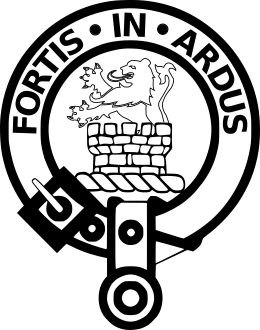Clan Middleton facts for kids
Quick facts for kids Clan Middleton |
|
|---|---|

Crest: Issuing out of a tower Sable, a lion rampant Gules, armed and langued Azure.
|
|
| Motto | FORTIS IN ARDUS ("Brave in difficulty") |
| Profile | |
| District | Laurencekirk, Kincardineshire |
| Clan Middleton has no chief, and is an armigerous clan | |
| Historic seat | Fettercairn House |
Clan Middleton is a Scottish clan from the Lowlands region. A "clan" is like a large family group, often with a shared history and a chief. The Court of the Lord Lyon officially recognizes this clan. This means they have a chief who is approved by the Lord Lyon King of Arms, Scotland's official in charge of coats of arms and clans.
Contents
History of Clan Middleton
Where the Clan Name Came From
The Middleton family likely got its name from lands near Laurencekirk in Kincardineshire, Scotland. The name "Middleton" means "middle town" or "middle farm."
Records from the late 1100s show that a man named Robert de Cunningham held land in the Laurencekirk area. This was confirmed by a special document from William the Lion, who was King of Scotland at the time.
In 1296, Humfrey de Middleton from Kincardyn signed the Ragman Rolls. This was a list of Scottish nobles who promised loyalty to Edward I of England. Another Middleton, Robert de Middleton, was captured at Dunbar Castle in the same year.
The 1600s: A Time of Change
The Middleton family became very important in the 1600s. John Middleton was a skilled soldier. He served in the French army before returning to Scotland.
He supported those who were against Charles I of England. John Middleton became a general and led cavalry troops. He helped defeat James Graham, 1st Marquess of Montrose at the Battle of Philiphaugh in 1645.
Middleton also helped negotiate when King Charles I surrendered. Later, he tried to help the king again but was captured twice. He was even put on trial for treason, but he escaped both times!
After King Charles II returned to power, he rewarded John Middleton. He made him the Earl of Middleton. John also became the Governor of Tangier, a city in North Africa, where he later passed away.
John Middleton's only son was Charles. He became the second and last Earl of Middleton. Charles worked as an ambassador and was a Secretary of State for Scotland.
He did not agree with King James II. Charles did not support the new rulers, Queen Mary and William of Orange. He then went to live in France.
His sons tried to invade Scotland with French soldiers. They were captured and sent to the Tower of London. Later, they were released. Because of these events, the family's title of Earl was taken away and never given back.
The 1900s: A Notable Middleton
Sir Thomas Middleton of Rosefarm was an important expert in farming. He was a deputy director during World War I. He became a Fellow of the Royal Society in 1936. This is a very high honor for scientists.
Castles of Clan Middleton
Here are some castles that the Clan Middleton has owned:
- Fettercairn House: This house is near the village of Fettercairn. It was once a castle, but a new house was built in 1666. It has been made larger over many years. This was the main home, or "seat," of the Middletons from the 1100s. The family lost the house after supporting the Jacobite rising of 1715. This means their property was taken away because they supported the wrong side in a rebellion.
- Balbengo Castle: This castle is south of Fettercairn. It was a tower house built in the 1500s. A larger mansion replaced it later. The Middletons bought it in 1687.
- Pitgarvie: This place is near Laurencekirk. The Middletons owned it in the late 1600s. There was an old castle or house there, but now it is likely a farm.


